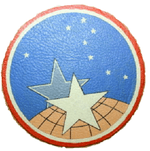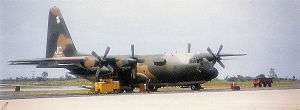7th Expeditionary Airborne Command and Control Squadron
7th Expedtionary Airborne Command and Control Squadron
 | |
|---|---|
|
EC-130E Hercules of the 7th ACCS at Korat[note 1] | |
| Active | 1942-1944; 1944-1946; 1954-1966; 1968-1998 |
| Country |
|
| Branch |
|
| Role | Airbrne Command and Control |
| Part of | Air Force Combat Command |
| Decorations |
Presidential Unit Citation Air Force Outstanding Unit Award with Combat "V" Device Air Force Outstanding Unit Award Philippine Presidential Unit Citation Republic of Vietnam Gallantry Cross with Palm[1] |
| Insignia | |
| 7th Expeditionary Airborne Command and Control Squadron emblem (approved 17 February 1977, revised 1994)[1] |
 |
| 7th Logistic Support Squadron emblem (approved 28 February 1956)[2] |
 |
| 7th Ferrying Sq emblem (approved 5 July 1945)[2] |
 |
The 7th Expeditionary Airborne Command and Control Squadronis part of the 379th Air Expeditionary Wing at Al Udeid Air Base, Qatar. It operates the E-8 Joint STARS aircraft, conducting airborne command and control missions.
History
The 7th ferried lend-lease aircraft to Alaska for turnover to Soviets from, June 1942–March 1944. It conducted aerial transportation in the Southwest and Western Pacific from, 13 December 1944–September 1945.
Reestablished in 1952 as a Headquarters. Air Force Logistics Command-controlled logistics squadron. Its mission was to provide worldwide airlift of nuclear weapons and related equipment, with a secondary mission to airlift other Department of Defense cargo as required when space was available. The squadron also provided airlift support during Cuban Missile Crisis from, 17 –28 October 1962. Inactivated in 1966.[1]
Became a Military Air Transport Service (later Military Airlift Command) C-124 Globemaster II strategic transport squadron flying worldwide airlift operations. Inactivated with retirement of C-124 in 1966.
Reactivated in 1968 and performed Airborne Battlefield Command and Control (ABCCC) mission in Southeast Asia from, 1 March 1968 – 15 August 1973 and controlled airborne forces during the recovery of the SS Mayagüez in May 1975, in Grenada from, 23 October–21 November 1983, in Panama from, December 1989–January 1992, and in Southwest Asia from, 1 September 1990 – 16 March 1991.[1]
In 1994, the 7 ACCS was moved from Keesler AFB, Mississippi, to Offutt AFB, Nebraska where it transitioned from EC-130 aircraft flying the ABCCC mission to the EC-135 aircraft flying the Airborne Command Post (ABNCP) "Looking Glass" mission in support of nuclear command and control for United States Strategic Command.[1] In October 1998, the "Looking Glass" mission was transferred to the Navy's E-6 fleet, the last of the US Air Force's EC-135 fleet was retired, and the 7 ACCS was inactivated.
In March 2008, the unit was again reactivated - this time as the 7th Expeditionary Airborne Command and Control Squadron (7 EACCS) - to be the forward operating squadron for E-8 Joint STARS supporting the United States Central Command Area of Responsibility.
Lineage
- 7th Ferrying Squadron
- Constituted as the 7th Air Corps Ferrying Squadron on 18 February 1942
- Activated on 24 March 1942
- Redesignated 7th Ferrying Squadron on 12 May 1943
- Disbanded on 1 April 1944
- Reconstituted and consolidated with the 7th Combat Cargo Squadron, the 7th Air Transport Squadron and the 7th Airborne Command and Control Squadron as the 7th Airborne Command and Control Squadron on 19 September 1985[1]
- 7th Combat Cargo Squadron
- Constituted as the 7th Combat Cargo Squadron on 25 April 1944
- Activated on 1 May 1944
- Inactivated on 15 January 1946
- Disbanded on 8 October 1948
- Reconstituted and consolidated with the 7th Ferrying Squadron, the 7th Air Transport Squadron and the 7th Airborne Command and Control Squadron as the 7th Airborne Command and Control Squadron on 19 September 1985[1]
- 7th Air Transport Squadron
- Constituted as the 7th Logistics Support Squadron on 22 June 1954
- Activated on 18 October 1954
- Redesignated 7th Air Transport Squadron, Special on 1 July 1964[note 2]
- Discontinued and inactivated on 8 January 1966
- Consolidated with the 7th Ferrying Squadron, the 7th Combat Cargo Squadron and the 7th Airborne Command and Control Squadron as the 7th Airborne Command and Control Squadron on 19 September 1985[1]
- 7th Expeditionary Airborne Command and Control Squadron
- Constituted as the 7th Airborne Command and Control Squadron and activated on 13 February 1968 (not organized)
- Organized on 1 March 1968
- Consolidated with the 7th Ferrying Squadron, the 7th Combat Cargo Squadron and the 7th Air Transport Squadron on 19 September 1985[1]
- Inactivated on 1 October 1998
- Redesignated 7th Expeditionary Airborne Command and Control Squadron and converted to provisional status on 4 December 2001[1]
Assignments
- North West Sector, Ferrying Command (later 7th Ferrying Group), 18 February 1942 – 1 April 1944
- 2d Combat Cargo Group, 1 May 1944 – 15 January 1946
- Warner Robins Air Materiel Area, 18 October 1954
- 3079th Aviation Depot Wing, 6 February 1955
- 39th Logistics Support Group, 1 July 1962
- 62d Troop Carrier Wing, 1 July 1963
- 63d Troop Carrier Wing, 1 July 1964 – 8 January 1966
- Pacific Air Forces, 13 February 1968 (not organized)
- Seventh Air Force, 1 March 1968
- 432d Tactical Reconnaissance Wing, 31 October 1968 (attached to Seventh Air Force)
- 388th Tactical Fighter Wing, 30 April 1972 (attached to Seventh Air Force to 15 August 1973, US Support Activities Group/Seventh Air Force to c. 21 May 1974)
- 374th Tactical Airlift Wing, 22 May 1974 (attached to Thirteenth Air Force)
- 3d Tactical Fighter Wing, 31 March 1975 (attached to Thirteenth Air Force)
- 507th Tactical Air Control Group, 14 August 1975
- 552d Airborne Warning and Control Wing (later 552d Airborne Warning and Control Division), 1 October 1976
- 28th Air Division, 1 April 1985 (attached to Air Division Provisional, 15, 5 December 1990 – c. 16 March 1991)
- 552d Operations Group, 29 May 1992
- 55th Operations Group, 19 July 1994 – 1 October 1988
- Air Combat Command to activate or inactivate any time after 4 December 2001
- 379th Air Expeditionary Wing, Undetermined dates[1]
Stations
|
|
Aircraft
- Douglas C-47 Skytrain (1944–1945)
- Curtiss C-46 Commando (1944–1945)
- Douglas C-124 Globemaster II (1954–1966)
- Lockheed EC-130 (1968–1994)
- Boeing EC-135 (1994–1998)[1]
- Boeing E-8 Joint STARS (??? - present)
Operations
- World War II
- Vietnam War
- Operation Urgent Fury
- Operation Just Cause
- Operation Desert Storm
- Operation Deny Flight
- Operation Deliberate Force
- Operation Decisive Endeavor
- Operation Uphold Democracy
- Operation Iraqi Freedom
- Operation Enduring Freedom
References
- Notes
- ↑ Aircraft is Lockheed EC-130E-LM Hercules serial 62-1857, taken 10 May 1974. This aircraft survived the Vietnam War and was converted to C-130E-II, later EC-130E in 1976 at Davis-Monthan AFB, Arizona
- ↑ This squadron is not related to the 7th Airlift Squadron, which was designated the 7th Air Transport Squadron, Heavy from 1 January 1965 to 8 January 1966, or to the 7th Air Transport Squadron (Transition Training Unit), which was organized by Military Air Transport Service at Great Falls Air Force Base, Montana on 1 June 48 and redesignated 1272d Transition Training Unit on 1 October 1948.
- Citations
Bibliography
![]() This article incorporates public domain material from the Air Force Historical Research Agency website http://www.afhra.af.mil/.
This article incorporates public domain material from the Air Force Historical Research Agency website http://www.afhra.af.mil/.
- Endicott, Judy G. (1998). Active Air Force Wings as of 1 October 1995 and USAF Active Flying, Space, and Missile Squadrons as of 1 October 1995 (PDF). Air Force History and Museums Program. Washington, DC: Office of Air Force History. ASIN B000113MB2. Retrieved July 2, 2014.
- Ravenstein, Charles A. (1984). Air Force Combat Wings, Lineage & Honors Histories 1947-1977 (PDF). Washington, DC: Office of Air Force History. ISBN 0-912799-12-9. Retrieved December 17, 2016.
